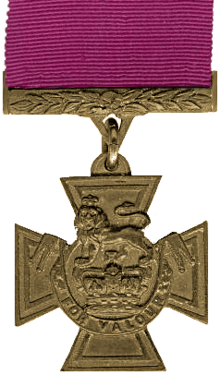Neville Elliott-Cooper
| Neville Bowes Elliott-Cooper | |
|---|---|
 | |
| Born |
22 January 1889 Lancaster Gate, London, England |
| Died |
11 February 1918 Hannover, Germany |
| Buried at | Hamburg Commonwealth War Graves Commission Cemetery |
| Allegiance |
|
| Service/branch |
|
| Years of service | 1908 - 1918 |
| Rank | Lieutenant Colonel |
| Commands held | 8th Battalion, The Royal Fusiliers |
| Battles/wars | World War I |
| Awards |
Distinguished Service Order Military Cross |
Lieutenant-Colonel Neville Bowes Elliott-Cooper VC DSO MC (22 January 1889 – 11 February 1918) was an English recipient of the Victoria Cross, the highest and most prestigious award for gallantry in the face of the enemy that can be awarded to British and Commonwealth forces.
Early life
Elliott-Cooper was born in January 1889 in London,[1] the youngest son of Sir Robert Elliott-Cooper, K.C.B. He was educated at Eton and the Royal Military College, Sandhurst.[2]
When he was 28 years old, and a Temporary Lieutenant Colonel commanding the 8th Battalion the Royal Fusiliers, British Army, he was awarded the Victoria Cross for his actions on 30 November 1917 east of La Vacquerie, near Cambrai, France during the Battle of Cambrai.
Citation
For most conspicuous bravery and devotion to duty. Hearing that the enemy had broken through our outpost line, he rushed out of his dug-out, and on seeing them advancing across the open he mounted the parapet and dashed forward calling upon the Reserve Company and details of the Battalion Headquarters to follow. Absolutely unarmed, he made straight for the advancing enemy, and under his direction our men forced them back 600 yards. While still some forty yards in front he was severely wounded. Realising that his men were greatly outnumbered and suffering heavy casualties, he signalled to them to withdraw, regardless of the fact that he himself must be taken prisoner. By his prompt and gallant leading he gained time for the reserves to move up and occupy the line of defence.
He died of his wounds whilst a prisoner of war on 11 February 1918 in Hannover, Germany.[2]
His Victoria Cross is displayed at the Royal Fusiliers Museum, Tower of London, England.
References
- ↑ Kelleher, JP (2010). "The Royal Fusiliers Recipients of the Victoria Cross for Valour" (PDF).
- 1 2 Elliott-Cooper, Neville Bowes, Commonwealth War Graves Commission
- ↑ The London Gazette: (Supplement) no. 30523. p. 2003. 12 February 1918. Retrieved 10 April 2015.
- Monuments to Courage (David Harvey, 1999)
- The Register of the Victoria Cross (This England, 1997)